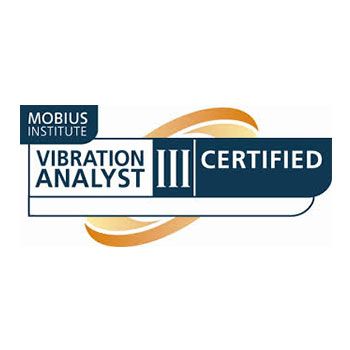ISO Category III Vibration Analyst - Advanced
Is intended for personnel who have at least two years vibration analysis experience and Category II certification by a recognized certification body. The course provides an in-depth study of diagnostic measurement techniques and the associated applications of the techniques
The Category-III course covers four days, with an additional day for review and the exam, is intended for people who are confident with spectrum analysis but who wish to push on and learn more about signal processing, time waveform and phase analysis, cross-channel testing, machine dynamics, and fault correction. If you wish to truly advance in vibration analysis and be able to run a successful condition monitoring team, then you are ready for this course. The course exceeds the ISO 18436-2 Category III standard and meets the ASNT Level III Recommended Practice.
You will leave the course with a solid understanding of:
- How a well-designed program and a reliability centered maintenance approach improve the OEE and therefore the bottom line
- The condition monitoring technologies: acoustic emission, infrared analysis (thermography), oil analysis, wear particle analysis, & motor testing via supplementary training
- How machines work; via supplementary selfstudy using the “Equipment Knowledge” section
- How to select the correct measurement location and axis, and collect good, repeatable measurements
- What the Fmax, resolution, averaging and other analyzer settings mean, and how to select the optimum settings for a wide variety of machine types
- How to analyze vibration spectra, time waveforms, envelope (demodulation), and phase measurements
- How to diagnose: unbalance, eccentricity, misalignment, bent shaft, cocked bearing, looseness, rolling element bearings faults, journal bearing faults, gearbox faults, resonance, and other conditions
- How to set alarm limits manually and with statistics
- How to balance and align a machine, and correct a resonance condition
Through this Certification Course, participants have the opportunity to accrue 5 Continuing Professional Development (CPD) points.
Review of condition monitoring technologies and the ISO standards
Signal processing and data acquisition
- Filters: Low pass, band pass, high pass, band stop
- Signal to noise ratio
- Analog and digital integration
- Testing low speed machines
- Sampling, aliasing, dynamic range
- Resolution, Fmax, data collection time
- Averaging: linear, overlap, peak hold, negative averaging, time synchronous
- Windowing and leakage
- Order tracking
- Cross channel testing
- Correlation and coherence
- Collecting data – ensuring you have the correct setup
- When should you use time waveform analysis
- Diagnosing unbalance, misalignment, bend shaft, eccentricity, cocked bearing,
- Collecting data
- Bubble diagrams
- Diagnosing unbalance, misalignment, bent shaft, eccentricity, cocked bearing, resonance, looseness and other conditions
- Natural frequencies and resonances
- Mass, stiffness and damping
- SDOF and MDOF
- Run-up coast down tests
- Bode plots and Nyquist (polar) plots
- Impact and bump tests
- Analysis of induction motors
- Can we prove the existing of a natural frequency?
- Visualizing vibration
- Setting up the job
- Collecting phase readings correctly
- Interpreting the deflection shape
- How does modal analysis differ from ODS?
- How does Finite Element Analysis (FEA) differ from modal analysis
- A quick review of the modal testing process
- The effect of mass and stiffness
- Beware of nodal points
- Adding damping
- A ‘trial and error’ approach
- A ‘scientific’ approach
- Isolation
- Tuned absorbers and tuned mass dampers
- Why do bearings fail?
- Cocked bearing, sliding on shaft or inside housing, looseness
- EDM and DC motors and VFDs
- Bearing frequencies and what to do when you don’t have all the details
- The four stages of bearing degradation
- Ultrasound
- High frequency detection techniques
- Shock Pulse, Spike Energy, Peak Vue, and other techniques
- Demodulation/enveloping
- Selecting the correct filter settings
- Spectrum analysis
- Time waveform analysis
- Low speed bearings
- What are journal bearings
- Measuring displacement
- Introduction to orbit plots
- Using your analyzer to acquire orbit plots
- Introduction to centerline diagrams
- Eccentricity ratio
- Glitch removal
- How the orbit changes with pre-load, unbalance, misalignment, instabilities, oil whir and whip
- How do motors work?
- Diagnosing a range of fault conditions: eccentric rotor, eccentric stator, soft foot, phasing, broken rotor bars, rotor bar and stator slot
- Unique fault conditions
- Flow turbulence, recirculation, cavitation
- Spectrum analysis versus time waveform analysis
- Wear particle analysis
- Gearmesh, gear assembly phase frequency (and common factors)
- Tooth load, broken teeth, gear eccentricity and misalignment, backlash and more
- General maintenance repair activities
- Review of the balancing process and ISO balance grades
- Review of shaft alignment procedures
- Setting baselines
- Setting alarms: band, envelope/mask, statistical
- Setting goals and expectations (avoiding common problems)
- Report generation
- Reporting success stories
Acceptance testing
Review of ISO standards

Course Info
- Dates
- 02 Jun - 06 Jun 2025 (JHB) VA-C3-6
- 20 Oct - 24 Oct 2025 (JHB) VA-C3-13
- Location
- Johannesburg
- Duration
- 5 Days
Course Length:
24 hours
License:
1 seat x 365 days*
